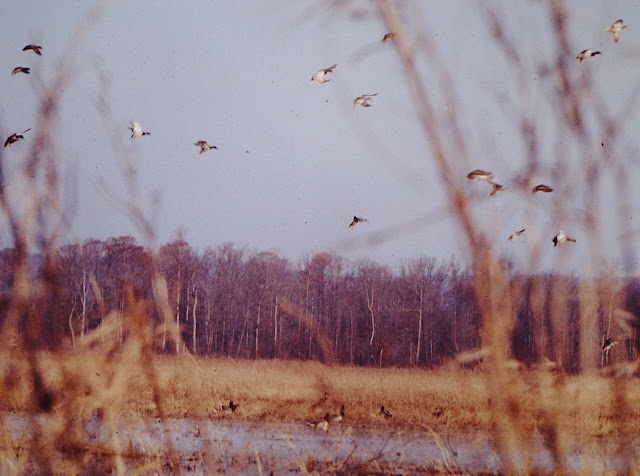 |
| USED TO BE: flock of ducks dropping into Schell-Osage marsh |
In the 1980’s when I lived in North Arkansas, some friends and I often went to southern Missouri to hunt ducks at a waterfowl conservation area known as Schell Osage. It was some of the best duck hunting you could find anywhere and back then I hunted ducks each year in several states and two provinces in Canada. There are few hunters who spent the hours I did in the marshes and wetlands hunting ducks. I loved it then as I do now. At the University of Missouri I studied to be a waterfowl biologist.
At Schell Osage the blinds were spaced well and the pools were full of smartweed. Ducks of all species loved it. It was built in 1962 on 1400 acres next too the Osage River to the west of El Dorado Springs, MO. It was planned and built by employees and equipment of the MISSOURI CONSERVATION COMMISSION, the effective and efficient (and honest) state agency that really did work towards the conservation, (wise use) of the state’s wildlife. That agency was the forerunner of the present day, Missouri Department of Conservation which I believe has become corrupt and inefficient.
As a full-time outdoor writer in those days when Schell-Osage was a premier waterfowl area, I wrote about hunting there, with articles in Outdoor Life, Gun Dog and Petersen’s Hunting magazines. One of the articles was entitled “A Day in Old F-13”. That blind was bad luck all the way around. It sat way off by itself near the river and over days and days, the records showed there were only a handful of ducks that were bagged in that blind by dozens of hunters. As luck would have it, we drew it one day in early winter.
I hunted often with a pair of Arkansas duck callers who were the best I ever heard, and that day a front moved through. New ducks came in by the hundreds. Duck calling is not only knowing how to imitate a mallard, but how to use different types of calls and when to use them. The men who taught me were the very best at doing that.
That day in 1978 we killed limits of greenhead mallards and three other species, then sat and watched the show for hours. Our young Labradors learned more in one day than they had learned the rest of the year.
But that was then. Today, thanks to the MDC, there is no Schell-Osage waterfowl area. And my prediction is that in my lifetime, and maybe longer, there will not be. It is now and it has been for years, a drained and bulldozed, ecological desert.
Several years ago, the Missouri Department of Conservation decided to obliterate what could have easily been redone and reconstructed, for very little money. A waterfowl haven built by employees of the Conservation Commission in two years back in ’62 was destroyed about 5 or 6 years back and has not been worked on since. Let me tell you why I think that is. The MDC allotted 18 million dollars for that reconstruction to be paid to several companies. Apparently one company has received most of the money and they are drawing interest on those millions of dollars. Does that give you an idea of why nothing is getting done?
Investigate it? Not a chance. Our legislators won’t touch the MDC. There is no one to investigate. Years back the state auditor called me and asked me to write about corrupt spending inside the MDC. She said her agency had found something the state’s citizens should know but the MDC had political autonomy so she couldn’t do a thing about it.
So figure up the interest on 18 million bucks. Just imagine that some higher-up employees or commissioners or ex-employees that guided that money where they wanted it to go, are getting paid well from that 18 million, which is not being spent, just sitting in several bank accounts.
Now you have an idea of why the Schell Osage waterfowl area will never be again. I feel sorry for local folks who made their living from thousands of out of state hunters who came there each winter to rent motel rooms and spend their money in local restaurants. That is a thing of the past, and so is the sound of wings over a spectacular marsh, and the sight of shorebirds along the edges of the pools. Now there is quiet. Now there is mud. Now there is 18 million dollars we all paid the MDC through that 1/8 cent sales tax and our license dollars. Where did it go? No one can ever know, no one can ever find out.
It was duck hunting to remember and I do. I have records from days I spent there through hundreds of photos. If only we had the men and dedication of an agency that could build such a place in two years… a group long forgotten men, called the Missouri Conservation Commission. And truthfully the marsh could be made to be what it was for less than a hundred thousand dollars before the bulldozers were called in. An MDC engineer told me that.
If you want to read more about the duck hunting at Schell-Osage, get my book “Memories From a Misty Morning Marsh”.





